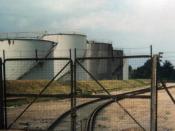Dow Chemical's CEO William Stavropoulos'
Decision Making Style
William Stavropoulos began his career with Dow Chemical in 1967 as a research chemist. He worked his way up through the company culminating with being appointed CEO on November 1, 1995. He led the company five years before stepping down from that position when he reached the mandatory retirement age of 60 in November of 2000. Under his leadership, Dow Chemical made a major transformation from a consumer products company to an industrial products company (Hodgetts, 1999). Mr. Stavropoulos' decision making style was vital to Dow's corporate structure.
There are four decision making styles: Democratic, autocratic, collective-participative and consensus. Democratic decision making is when the leader gives up ownership and control of a decision and allows the group to vote. Autocratic decision making is when the leader maintains total control and ownership of the decision. Collective-participative decision making is when the leader involves the members of the organization.
Consensus decision making is when the leader gives up control of the decision (Daugherty, 1997). There are advantages and disadvantages to each style. Depending on the situation, one style could be better than another. Mr. Stavropoulos' used a collective-participative decision making style. He wanted to change the corporate culture so that it supported his management strategy. In particular, he wanted to make more demands on performance and to create more accountability in the system. Previously they were an organization that was matrixed and depended on teamwork but there was no one in charge. When things went well, they didn't know whom to reward; and when things went poorly, they didn't know whom to blame. So he created a global business structure and cut out layers of management. There used to be 11 layers between Mr. Stavropoulos and the lowest-level employees. Now there are...


